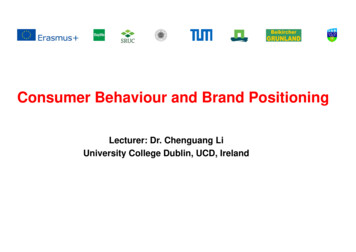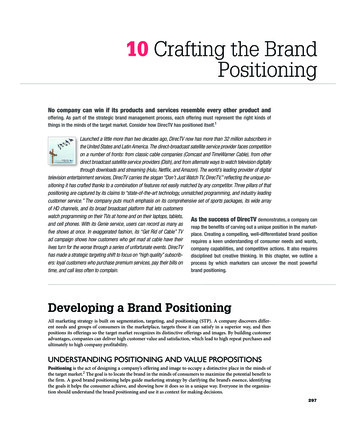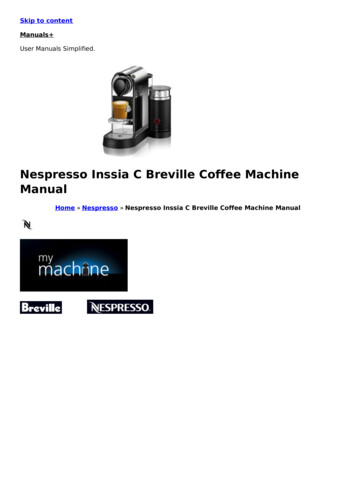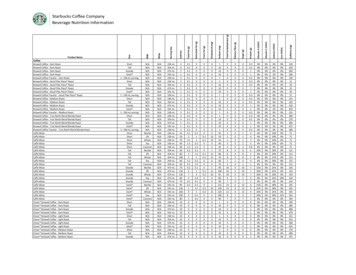
Transcription
International Journal of Economics, Commerce and ManagementUnited KingdomVol. III, Issue 5, May 2015http://ijecm.co.uk/ISSN 2348 0386BRAND POSITIONING STRATEGIES OF COFFEE SHOPSIN TURKEY: A COMPARATIVE STUDY OFSTARBUCKS & COSTA COFFEESameer Sehrawala [Sumair]Department of Business & Management, The Graduate School (Institute) of Social Sciences,Istanbul Aydin University, Istanbul, Turkeysameer@sehrawala.comİlkay KaradumanDepartment of Business & Management, The Graduate School (Institute) of Social Sciences,Istanbul Aydin University, Istanbul, Turkeyilkaykaraduman@aydin.edu.trAbstractBrand Positioning is a mandatory notion in field of marketing. Brand positioning help consumerto choose product that delight their need, arrogate their passions then reward them toinaugurate their position in civilization. The aim to this research is to evaluate the brandpositioning strategy of coffee shops in Turkey, a comparative study from customers’ point ofview (Starbucks & Costa Coffee). This pragmatic research taking through logical analysis theexisting literature, notable to the evaluation of a hypothetical background. Coffee shops inTurkey are placing a focus on the brand positioning strategy, it is necessary for the coffee shopsto strategically find a way to get a competitive advantage over the others as a marketingstrategy, as there exists several competitors. The study has been taken by qualitative andquantitative methods of research by conducting a self-structure online questionnaire survey.The questionnaires were completed by consumers. The data was subject Statistical Package forthe Social Sciences (SPSS) to establish the outcomes of the primary research. The findingspresented that the brand positioning strategy of coffee shops in Turkey are significantly relatedto the quality of the factors, which Starbucks achieved and Costa Coffee withdraw from market.Keywords: Brand positioning strategy, Coffee, Coffee shops in Turkey, Starbucks, Costa CoffeeLicensed under Creative CommonPage 541
Sameer & İlkayINTRODUCTIONToday's globe is extra moveable unsystematic and encouraging than smooth previous. Theessential benefit of performing job successfully are changing. Globalization, unpredictableconsumer demands, strong competition and ups and down in economical (private) andgovernmental set-up push organization's to absorb fast and execute themselves toenvironmental deviations. Today's customers‟ profiles are sharp in demanding, how theydesire? When they desire? What they desire and what they will compensation for it?When brand and branding started in late 1940‟s (Guest, 1942), there has beenconsistent recognition that branding offers organizations a means for differentiation in marketswith similar offerings (Gardner & Levy 1955, Aaker 1991, Keller 2003, Kotler et al 2007).Branding is hence measured mutually and constructive from both the demand and supplyperspective. The aim of branding is expansion of profound and continuing relationship with thecustomer because customer selecting the brand according to their attitude, values, lifestyle andsocial status. Harsha (1997), one of the most effective tools in hospitality industry branding isthe brand position strategies as it evokes an image of a cafe in the customer‟s mind thatdifferentiates it from the competition.Brand positioning has an important role in helping businesses position in an industry(Okutoyi, 1992). Effective brand positioning may enable a business to influence the environmentin its favor and even defend itself against completion. The consequence of positioning is theactual formation of a consumer drive value intent, a solid cause why the target market shouldpurchase the service or product?” (Kotler 2003, page 308).Main foundations to form the consumer preference to a brand are positioning strategies.How consumer observe the existing brand by evoking the organization‟s statement are vital toevaluate the consumer. To figure the precise image of a bran in the mind of consumer, accuratepositioning strategy is mandatory for accurate time.Prior to anxiety for coffee and coffee shops brand positioning, Subsequently Oil, coffeeis the 2nd greatest important exported allowed product in the world. Coffee performed adynamic part for development of chatting space for people to intellects with friends and familyfrom all edges of life to assemble. After the presented coffee in the Europe it renowned for itsgeniality and its sensitivity. Rapidly, coffee shops remained in all Europe and true place forsocial discussion, fictional discussion and for governmental discussion.Biggest challenge for coffee shops is to understand their customer and for that they haveto understand the wants, needs and demands of their customer. Coffee shops are valuablewhen customers started to pay good price not only for great cup of coffee but for further value inLicensed under Creative CommonPage 542
International Journal of Economics, Commerce and Management, United Kingdomorder that the coffee shop deliver. Coffee shops are growing and taking new ideas and movingto the marketable and profitable trends. Coffee shops are providing additional food choices andincreasing their opening hours to grow the market share.The coffee shop market is growing and influencing the expansion in Turkey. Thepragmatic research was passed out at one of the primary coffee shop chains that are Starbucksand Costa Coffee.Purpose of the StudyTo investigate the brand positioning strategies of coffee shops in Turkey, A comparative studywith a customer point of view (Starbucks & Costa Coffee).Problem FormulationThere is broad covenant that the idea of positioning has been one of the essential mechanismsof current marketing management (Hooley et al., 2001). The seeming diversity and the targetmarket from competitors are essential ideas of positioning (Kinuthia, 2002).It seems surprising that not much study has apparently been carried out providing acomprehensive analysis of current issues in coffee shops brand positioning strategy in Turkey.Coffee shops are retaining a concentration on the brand positioning strategy, it is necessary forthe coffee shops to strategically find a way to get a better position over the others as a marketstrategy, as there exists a lot of challengers.An understanding of individual aspects of branding literature does not imply an overallunderstanding of the coffee shops brand positioning situation and problems. For the purposes ofan in-depth investigation, survey is desired to sustenance with a comprehensive view of coffeeshops brand positioning and its situation. Therefore, it is hoped that the existing study may be arewarding direction for further exploration.Research Questions What are the brand positioning strategies of coffee shops in turkey? How Starbucks and Costa Coffee develop and maintain their brand and what are theposition (brand image and identity) they want in customers mind? Customers are drinking coffee so they are brand conscious, if yes so which brand andwhat is the image of that brand in their mind? Are the coffee shops (Starbucks and Coast Coffee) in Turkey meeting the customer‟sexpectations (in term of product and service)?Licensed under Creative CommonPage 543
Sameer & İlkayLITERATURE REVIEWBrandThe brand has been defined in many different ways reliant on the viewpoint, the brand isseeming by different academics (De Chernatony & Riley, 1998; Keller, 2008). But the classicaldefinition of brand is: "Name, term, design, symbol, or any other feature that identifies oneseller's goods or service as distinct from those of other sellers” (AMA, 1990). According toKaperer (1992, page12) “brand is not a product; it is the product’s source, its meaning, itsdirection, its definition, its identity in time and space”. Brand is a corporate strength and thevalue to a business of owning strong brands is incontestable (Ahmad, et al, 2003).Brands as resources can be a sustainable competitive advantage if they arecharacterized by “value, rarity, durability, inappropritability, imperfect imitability, and imperfectsubstitutability” (Balmer & Gray, 2003, p. 991). A strong brand also acts as a basis of diversitysystematic its title, pictogram or personality (Doyle, 1990; Aaker, 1996; Aaker, 1997).A tough and worthy brand is measured to take corporations further business, it helpbusinesses building (Keller, 2003, Kapferer, 2004; Aaker, 1991), maintain market share, lovecustomer loyalty, decrease price (Ghodeswar, 2008), superior safety of challenges and profit(Miller & Muir 2004). Brands also play a crucial role from the consumers‟ perspective. Thebenefits that a brand can bring include: helping to create loyalty, protective a brand from thethreat of competition, communicating features and benefits (Cunningham, 2006; Vranesevic andStancec, 2003).Brand is not only provided economic value for money for consumers, but also solvesconsumer problems and provides psychological satisfaction with the requisite quality ofproducts. Oxford University Professor Mr. Douglas Holt (in his book: How Brands BecomeIcons) proposes these three principles (1) Symbolic brands progress a position that exceedspractical benefits (2) Symbolic brands develop identity myths (3) The brand comes to embodythe myth. Brand has three basic functions; (1) it help us recognize things (2) it steer ourexpectations (3) It evoke emotional responses.PositioningPositioning is perhaps one of the thorniest and most complex concepts in marketing (Bhat andReddy, 1998). Positioning is not what you do to a product; positioning is what you do to themind of the prospect (Ries & Trout), you position the product in the mind of the prospect (1986,p. 2). As elaborated upon in the introduction, it was Ries and Trout‟s best-selling book„Positioning: The Battle for Your Mind‟ that popularized positioning in theory and practice. Theauthors argued that in an “over-communicated society”, in which the volume of commercialLicensed under Creative CommonPage 544
International Journal of Economics, Commerce and Management, United Kingdommessages far exceeds the individual‟s mental processing capacity, marketers must focus onhow to get into the minds of consumers (Ries & Trout, 2001). Holt (2004) described thisperspective as the “mind-share” approach that had become the common leitmotif in marketingresearch and practice. The significant ideas around positioning are: It‟s not tactical, it‟s completestrategic activity, It‟s aimed at maintaining competitive advantage and evolving a strategic, It‟sanxious with handling insights, Brand reputation and image are the outcome of the positioningprocess.Brand Positioning"Building or rebuilding an image” for a brand is brand positioning (Biel, 2006). Brand positioningis a tool of strategic brand management. With respect to the link between the brand and itspositioning in the mind of the customers, marketers should repeat the auditing process andadjust brands accordingly (Marsden, 2002, p. 307). The focus of the brand positioning is theperception of brand features. These features can be perceived as positive, neutral or negative.There are four core elements, which must be taken in consideration when developingbrand positioning, (1) brand equity (2) target consumer group (3) consumer benefit and (4)competitive frame. Positioning action including changes to (Van den Ven, 2007, p. 216), Ideas(which brand position and story to choose), People (actors‟ involvement in brand positioning),Transactions (sequences of decisions and actions) and Context (what the relevantcircumstances for brand positioning projects are).Brand Positioning StrategiesIt‟s an essential part of brand strategy. Brand positioning strategies is also an important part inthe marketing, organizations have to practice the elements in the marketing mix to impact thepatrons appreciative of the position (Solomon 2000). Once a positioning strategy is found(integrated marketing communication) then aims to ensure consistency in delivering thepositioning strategy (Mavondo, Luxton & Reid, 2005; Moriarty & Duncon, 1998).STARBUCKSStarbucks is a United States of America‟s, world coffee organization and biggest coffee shopchain founded in 1971, Seattle, Washington. Starbucks has 20,737 coffee shops in 63countries, such as Canada - 1,442, China - 1,496, Japan - 1,052, Turkey - 224, United Kingdom– 772 and United States - 11,910. Since 1987, Starbucks has expanded rapidly. The companyderives its revenues from three operating segments: United States of America (USA),International and global, Consumer products group (CPG).Licensed under Creative CommonPage 545
Sameer & İlkayStarbucks launched community website in 2008, in the name of My Starbucks Idea, with goal totake feedback and suggestions from customers. Starbucks announced loyalty program in May,2008, for registered customer of the Starbucks card, then in the beginning of 2009 Starbuckcome up with its mobile app (beta testing) for Starbucks card customers with the facility ofconsumer access pre-paid fund to buy products. Starbucks introduce complete mobile platformin 11th January, 2011.Through mobile devices by Starbucks app, over 10% of product sale made in July, 2013.In October, 2013, Starbucks launch the "Tweet-a-Coffee" campaign. This research conductedby firm Keyhole monitored. In September, 2014, Starbucks had integrated the taxi-orderingprogram Uber into its app.In October 2014 Starbucks launched a global campaign „Meet Me at Starbucks‟ whichutilized a wide range of online channels such as YouTube, Instagram, Tumblr and Twitter,aimed to emphasize the positive aspects of its global brand. In November 2014 Starbucksadvertised the fact that customers could now use their Starbucks Card and mobile app atWelcome Break stores. In December, 2014, Starbucks launched a competition, offeringcustomers the chance to win a lifetime‟s supply of drinks (one per day) as part of the „It‟s aWonderful Card‟ campaign. The winning customer will
Harsha (1997), one of the most effective tools in hospitality industry branding is the brand position strategies as it evokes an image of a cafe in the customer‟s mind that differentiates it from the competition. Brand positioning has an important role in helping businesses position in an industry (Okutoyi, 1992). Effective brand positioning may enable a business to influence the environment .File Size: 694KBPage Count: 32











